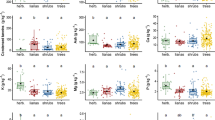Summary
The palatability of 14 species of woody plant was assessed for three species of browsing ruminant, namely kudus, impalas and goats. Results show that palatability was most clearly related to leaf contents of condensed tannins. The effect was a threshold one, with all plants containing more than 5% condensed tannins being rejected as food during the wet season period. In contrast palatability was not influenced by concentrations of protein-precipitating polyphenols, and only weakly related to contents of nitrogen, phosphorus, cations, fibre components and other secondary metabolites. Insect herbivory shows a different pattern. These findings support the hypotheses that (i) condensed tannins function to protect plant cell walls against microbial attack; (ii) hydrolyzable tannins function to inactivate the digestive enzymes of insect herbivores. Large mammalian herbivores are influenced by condensed tannins due to their dependance upon microbial fermentation of plant cell walls for part of their energy needs.
Similar content being viewed by others
References
Baldwin IT, Schultz JC (1983) Rapid changes in tree leaf chemistry induced by damage: evidence for communication between plants. Science 221:277–279
Bate-Smith EC (1973) Haemanalysis of tannins: the concept of relative astringency. Phytochem 12:907–912
Bate-Smith EC (1977) Astringent tannins of Acer species. Phytochem 16: 1421–1426
Cates RG, Rhoades DF (1977) Patterns in the production of antiherbivore chemical defences in plant communities. Biochem Syst Ecol 5:185–193
Gould SJ, Vrba ES (1982) Exaptation — a missing term in the science of form Paleobiology 8:4–15
Daiber KH (1975) Enzyme inhibition by polyphenols of Sorghum grain and malt. J Sci Fd Agric 26:1399–1411
Harborne JB (1973) Phytochemical Methods, a guide to modern techniques of plant analysis. Chapman and Hall, London
Harmse HJ von M (1977) Grondsoorte van die Nylsvley-Natuurreservaat. S A Nat Sci Progr Rep 12:1–41
Haukioja E, Niemela P (1979) Birch leaves as a resource for herbivores: seasonal occurrence of increased resistance in foliage after mechanical damage of adjacent leaves. Oecologia (Berlin) 39:151–159
Horowitz W (1980) Official methods of analysis of the Association of Official Analytical Chemists. A.O.A.C. Washington DC
Jerumanis J (1972) Über die Veränderung der Polyphenole im Verlauf des Malzens und Maischens. Brauwissenschaft 25:313–322
McKey D (1979) The distribution of secondary compounds within plants. In: Rosenthal GA, Janzen DH (eds) Herbivores, their Interaction with Secondary Plant Metabolites. Academic Press, New York, pp 55–134
McLeod MN (1974) Plant tannins — their role in forage quality. Nutrition Abstracts and Reviews 44:803–815
Owen-Smith N, Cooper SM (1985) Comparative consumption of vegetation components by kudus, impalas and goats in relation to their commercial potential as browsers in savanna regions. S Afr J Sci 81:72–76
Rhoades DF, Cates RG (1976) Towards a general theory of plant antiherbivore chemistry. Rec Adv Phytochem 10: 168–213
Rutherford MC (1982) Aboveground biomass categories of woody plants in a Burkea africana-Ochna pulchra savanna. Bothalia 14:1–131
Scholtz CM (1982) Trophic ecology of lepidoptera larvae associated with woody vegetation in a savanna ecosystem. S A Nat Sci Progr Rep 55:1–25
Swain T (1977) Secondary compounds as protective agents. Ann Rev Plant Physiol 28:479–501
Swain T (1979) Tannins and lignins. In: Rosenthal GA, Janzen DH (eds). Herbivores, their Interaction with Secondary Plant Metabolites. Academic Press, New York, pp 657–682
van Hoven W (1984) Trees' secret warning system against browsers. Custos 13:11–16
Van Soest P (1982) The Nutritional Ecology of the Ruminant. O&B Books, Corvallis, Oregon, USA
Zucker WV (1983) Tannins: does structure determine function? An ecological perspective. Am Nat 121:335–365
Author information
Authors and Affiliations
Rights and permissions
About this article
Cite this article
Cooper, S.M., Owen-Smith, N. Condensed tannins deter feeding by browsing ruminants in a South African savanna. Oecologia 67, 142–146 (1985). https://doi.org/10.1007/BF00378466
Received:
Issue Date:
DOI: https://doi.org/10.1007/BF00378466




